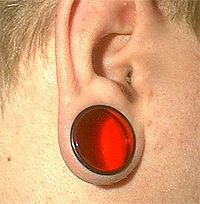Acrylic
Acrylic (including the brand name Lucite) is a transparent, glassy thermoplastic invented by DuPont in 1931 while researching high-pressure technologies needed for ammonia production. A revolutionary plastic at the time, it had both low density and was stronger than previous plastics, as well as having excellent water and UV resistance.
In the 1950s, acrylic became popular as jewelry (not body jewelry), and of course, since the 1990s, it has been widely used for both stretched body piercings and normal body piercings—it can be used to make almost anything.
The material is usually translucent and colored, but is also available clear or opaque. Some piercers feel this jewelry is inappropriate, especially for fresh piercings, under the theory that the body can break down the plastic, releasing acrylic acids.
Seedpower wrote to add,
- Many piercers may not want to use it for fresh or healing piercings based on the lack of comparable medical usage, no ASTM implant specs, inconsistency from plastic to plastic, and the inability to sterilize without melting. This last one is, of course, crucial to fresh piercings!
- Dental acrylic should also be mentioned. Some dental acrylic has shown to work, not necessarily in the body, but in applications where it comes into contact with mucus membrane. Another plus to dental acrylic is that most seems to work fine in an autoclave.
Warning: Do not expose acrylic jewelry to alcohol, as it will crack. In addition, acrylic is sensitive to rapid changes in temperature. It should be noted that longer acrylic jewelry such as a taper or ring, can actually be reformed using the heat of a toaster oven (although if too much heat is applied, the surface will bubble or burn and the jewelry will be destroyed, so be careful).
A note to would-be-manufacturers: Acrylics are available in cast or extruded forms. Cast plastics are dramatically easier to machine (as they tend to powder rather than melt). Small amounts of plastics can be bought from warehouses and hobby and craft shops in most major cities. Plastic jewelry is easy to form and finish even using nothing more than simple hand tools.
